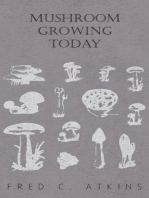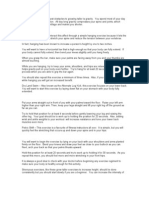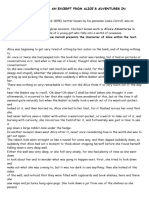Czapek Dox Media Oxoid Product Detail
Czapek Dox Media Oxoid Product Detail
Uploaded by
Chandra MohanCopyright:
Available Formats
Czapek Dox Media Oxoid Product Detail
Czapek Dox Media Oxoid Product Detail
Uploaded by
Chandra MohanOriginal Title
Copyright
Available Formats
Share this document
Did you find this document useful?
Is this content inappropriate?
Copyright:
Available Formats
Czapek Dox Media Oxoid Product Detail
Czapek Dox Media Oxoid Product Detail
Uploaded by
Chandra MohanCopyright:
Available Formats
10/28/2014
CM0097, Czapek Dox Media | Oxoid - Product Detail
Dehydrated Culture Media
CZAPEK
DOX AGAR
You are viewing the printer friendly version of this page. To return to the regular view click here.
(MODIFIED)
Code: CM0097
a solid defined medium for the cultivation of those fungi and bacteria which are able to utilise sodium
nitrate as the sole source of nitrogen. The acidity of the medium may be increased for the cultivation
of acidophilic organisms such as yeasts.
Typical Formula*
gm/litre
Sodium nitrate
2.0
Potassium chloride
0.5
Magnesium glycerophosphate
0.5
Ferrous sulphate
0.01
Potassium sulphate
0.35
Sucrose
30.0
Agar
12.0
pH 6.8 0.2 @ 25C
* Adjusted as required to meet performance standards
Directions
Suspend 45.4g in 1 litre of distilled water. Bring to the boil to dissolve completely. Sterilise by
autoclaving at 121C for 15 minutes. Mix well before pouring. If required, adjust the reaction to pH 3.5
0.2 by adding 10ml of Lactic Acid 10% (SR0021) per litre after sterilisation.
Description
Czapek Dox Agar (Modified) is a medium containing sodium nitrate as the sole source of nitrogen, it
is one of the most useful solid media for the general cultivation of fungi.
In the Oxoid medium magnesium glycerophosphate and potassium sulphate replace the magnesium
sulphate and potassium phosphate of the original. This modification prevents the precipitation of
magnesium phosphate. The medium is also a highly satisfactory substrate for chlamydospore
production by Candida albicans 1.
Dawson1 employed Oxoid Czapek Dox Agar (Modified) in her technique for the identification of
Candida albicans by chlamydospore formation in primary culture, using swabs taken from the mouth
and from the vagina. Identification was usually possible within 24 hours. The Oxoid medium showed
good chlamydospore production whereas the original formulation did not. After 24 hours incubation 23
out of 27 Candida albicans strains had formed chlamydospores on Oxoid Czapek Dox Agar (Modified),
21 on rice infusion agar, 10 on Oxoid Corn Meal Agar (CM0103) and 10 on a corn meal agar made in
the laboratory. After 48 hours 25 strains had formed chlamydospores on both the Oxoid medium and
the rice agar, 24 on Oxoid Corn Meal Agar and 20 on the laboratory medium. Dawson concluded that
the Oxoid Czapek Dox medium and the rice infusion agar were the most satisfactory media. None of
14 strains of unidentified yeasts formed chlamydospores on any medium.
Smith2 cited the following recommendations for the use of Czapek Dox Agar for taxonomic studies:
by Thom and Church3 for Aspergillus; by Thom4 and by Raper and Thom5 for Penicillium; and by
Wakesman6 for actinomycetes.
Technique
General Cultivation
To avoid excessive condensation cool the molten medium to 50C before pouring approximately 12ml
into each 9cm diameter Petri dish. Store the poured plates in an inverted position and inoculate using
a needle or wire, with the plate still inverted in order to avoid scattering stray fungal spores over the
surface of the medium. Time and temperature of incubation vary considerably according to the
species being cultivated. As a general guide, incubate for 1-2 weeks at 25C. Most Penicillium
species have an optimum growth temperature between 20 and 25C, whilst many Aspergillus species
grow best at about 30C. However, different fungi grow over a wide range of temperatures;
Aspergillus fumigatus grows well at 50C (Smith2) and Cladosporium herbarum will grow on meat at
-6C 7,8.
http://www.oxoid.com/UK/blue/prod_detail/prod_detail.asp?pr=CM0097&c=UK&lang=EN&org=&print=Y
1/2
10/28/2014
CM0097, Czapek Dox Media | Oxoid - Product Detail
Identification of Candida albicans 1
1. Using an inoculating needle (previously flamed, cooled and rubbed against the swab) cut
across and through the medium in a Czapek Dox Agar plate to the base of the petri dish. With
the same needle, raise the medium along the whole of one side of the cut - so that the
inoculum is spread between the agar and the base of the dish.
2. Incubate the inoculated plates for 24 hours at 28C.
3. Using a low-power objective, microscopically examine the unopened plates for chlamydospores
through the base of each dish. Alternatively, remove the tops of the dishes, and examine
through the top of the medium.
4. If no chlamydospores are seen, incubate for a further 24 hours and re-examine.
Storage conditions and Shelf life
Store the dehydrated medium at 10-30C and use before the expiry date on the label.
Store the prepared agar plates at 2-8C.
Appearance
Dehydrated medium: White coloured, free-flowing powder
Prepared medium: Off-white coloured gel
Quality control
Positive control:
Expected results
Aspergillus niger ATCC 9642 * White / yellow mycelium, black spores
Candida albicans ATCC 10231 *
Good growth; cream coloured colonies
Negative control:
Uninoculated medium
No change
* This organism is available as a Culti-Loop
References
1. Dawson Christine O. (1962) Saboutaudia 1. 214-219
2. Smith G. (1960) An Introduction to Industrial Mycoloogy 5th ed., Edward Arnold Ltd., London.
3. Thom C. and Church M. B. (1926) The Aspergilli Williams and Wilkins Co. Baltimore.
4. Thom C. (1930) The Aspergilli Williams and Wilkins Co. Baltimore.
5. Raper K. B. and Thom C. (1949) Manual of the Penicillia Williams and Wilkins Co. Baltimore.
6. Wakesman S. A. (1931) Principals of soil Microbiology Bailliere Tindall and Cox, London.
7. Brooks F. T. and Kidd M. N. (1921) Specia. Report No 6, Food Invest. Board, DSIR, London.
8. Brooks F. T. and Handsford C. G. (1922) Trans. Brit. Mycol. Soc. 8. 113-142.
2001 - 2014 Oxoid Limited, All rights reserved.
Copyright, Disclaimer and Privacy Policy | Conditions of Sale | About Us | Cookies
Thermo Fisher Scientific Inc.
http://www.oxoid.com/UK/blue/prod_detail/prod_detail.asp?pr=CM0097&c=UK&lang=EN&org=&print=Y
2/2
You might also like
- Oxoid - SdaDocument1 pageOxoid - SdaDidik PrasetyaNo ratings yet
- BBL Sabouraud Dextrose Agar, Emmons: ™ L007406 - Rev. 09 - August 2006Document2 pagesBBL Sabouraud Dextrose Agar, Emmons: ™ L007406 - Rev. 09 - August 2006Iedwal Dwi RNo ratings yet
- Conda Lab Dextrose Sabouraud 1024 - en - 3Document2 pagesConda Lab Dextrose Sabouraud 1024 - en - 3Natália DiasNo ratings yet
- Campylobacter4 PDFDocument15 pagesCampylobacter4 PDFmohammednazeerNo ratings yet
- Diaslide CLED-MAcConkey UCD-For More Information Click HereDocument7 pagesDiaslide CLED-MAcConkey UCD-For More Information Click HereMikey MadRatNo ratings yet
- Sabouraud Dextrose Agar (European Pharmacopoeia) : CAT Nº: 1024Document0 pagesSabouraud Dextrose Agar (European Pharmacopoeia) : CAT Nº: 1024Fred GreenNo ratings yet
- Teknis Identifikasi Jamur Biakan IdentifikasiDocument47 pagesTeknis Identifikasi Jamur Biakan IdentifikasiSo FunnNo ratings yet
- TC Boite Contact Baird Parker Double Emballage Irradie x30 18125006302 enDocument2 pagesTC Boite Contact Baird Parker Double Emballage Irradie x30 18125006302 enahmed galalNo ratings yet
- Oxoid - CM0115Document2 pagesOxoid - CM0115Ziaf ZedNo ratings yet
- Diaslide DS-101 InsertDocument7 pagesDiaslide DS-101 InsertshinhyejjNo ratings yet
- Sabouraud Dextrose BrothDocument2 pagesSabouraud Dextrose Brothf.baxyNo ratings yet
- Lab Report-Yeast MouldDocument20 pagesLab Report-Yeast MouldAinaa Fatehah56% (9)
- TCBSDocument13 pagesTCBSMohammad Aklis AzmiNo ratings yet
- Littman Oxgall Agar W/ Streptomycin: Intended UseDocument1 pageLittman Oxgall Agar W/ Streptomycin: Intended UseJUAN PABLO VERGARA REYESNo ratings yet
- 01-695 TDS enDocument3 pages01-695 TDS enJuan LuisNo ratings yet
- Slide Show v 12.0 EUCAST Disk Test 2024Document43 pagesSlide Show v 12.0 EUCAST Disk Test 2024scribdonurNo ratings yet
- Purification Bacteria CultureDocument5 pagesPurification Bacteria CultureWan Nabil0% (1)
- Amies Charcoal PDFDocument2 pagesAmies Charcoal PDFradiny audiaNo ratings yet
- IFU1630Document1 pageIFU1630tecoluigiNo ratings yet
- Biggy Agar (Bismuth Glucose Glycine Yeast Agar) : Instructions For Use - Ready-To-Use Plated MediaDocument3 pagesBiggy Agar (Bismuth Glucose Glycine Yeast Agar) : Instructions For Use - Ready-To-Use Plated MediaShoaib MughalNo ratings yet
- Bam 2001 Chapter 18Document11 pagesBam 2001 Chapter 18diasaripermataNo ratings yet
- Compact Dry: An Easy Test Method For Counting MicroorganismsDocument12 pagesCompact Dry: An Easy Test Method For Counting MicroorganismsSyeda Nazish BokhariNo ratings yet
- Chocolate AgarDocument4 pagesChocolate AgarMaria Chacón CarbajalNo ratings yet
- Ref19 Sporicidal Properties of H2O2 Against Food SpoilageDocument6 pagesRef19 Sporicidal Properties of H2O2 Against Food SpoilagebaronNo ratings yet
- Corn Meal Agar: Intended UseDocument2 pagesCorn Meal Agar: Intended Usealbdanyghmdan609No ratings yet
- Pf6820en MKDocument2 pagesPf6820en MK4om.laboratorioNo ratings yet
- My Project ReportDocument15 pagesMy Project Reportmohd adilNo ratings yet
- Yeast Carbohydrate Fermentation Broth (Yfb) : ProductDocument2 pagesYeast Carbohydrate Fermentation Broth (Yfb) : ProductlalaanhNo ratings yet
- Lab Report MicrobiologyDocument16 pagesLab Report MicrobiologyOliaNo ratings yet
- Chocolate AgarDocument5 pagesChocolate AgarBramita Beta ArnandaNo ratings yet
- BBL Chromagar Candida: ™ ™ 8012620 - Rev. 01 - October 2008Document3 pagesBBL Chromagar Candida: ™ ™ 8012620 - Rev. 01 - October 2008Pasquale VitaleNo ratings yet
- CLED AgarDocument4 pagesCLED Agarsameera ruffaiNo ratings yet
- 0851 en 1Document2 pages0851 en 1WILLIAM JOSE HERRERA HERNANDEZNo ratings yet
- Hydrolysis of Tuber Peels and Sorghum Chaff by Cellulolytic Culture Filtrates of Aspergillus Niger AC4 Isolated From Agricultural Waste DumpsitesDocument7 pagesHydrolysis of Tuber Peels and Sorghum Chaff by Cellulolytic Culture Filtrates of Aspergillus Niger AC4 Isolated From Agricultural Waste DumpsitesAlexander DeckerNo ratings yet
- Materials and Methods 3Document8 pagesMaterials and Methods 3Suresh ChanderNo ratings yet
- Microbiology Compact-Dry Brochure-12p 2019-03 enDocument12 pagesMicrobiology Compact-Dry Brochure-12p 2019-03 ens-noor-18No ratings yet
- Collection, Isolation of SalmonellaDocument31 pagesCollection, Isolation of SalmonellaUmar ChaudharyNo ratings yet
- Biotechnology Lab Manual Offered To Iii Year B.Tech Chemical EngineeringDocument34 pagesBiotechnology Lab Manual Offered To Iii Year B.Tech Chemical Engineeringanon_348923763No ratings yet
- Biotechnology Lab ManualDocument34 pagesBiotechnology Lab Manualanon_348923763No ratings yet
- Improved Cordycepin Production in A Liquid Surface Culture of Cordyceps Militaris Isolated From Wild StrainDocument29 pagesImproved Cordycepin Production in A Liquid Surface Culture of Cordyceps Militaris Isolated From Wild StrainShelly SharmaNo ratings yet
- 20BT2052 Atc - PTC ManualDocument25 pages20BT2052 Atc - PTC ManualvenkatesangNo ratings yet
- TDS - CCA AGAR - BK204 - BM182 - EN V4.cleanedDocument4 pagesTDS - CCA AGAR - BK204 - BM182 - EN V4.cleanedReza FebryantaraNo ratings yet
- Campylobacter Agar Base Blood Free (CCDA) ISO: Industry RegulationsDocument2 pagesCampylobacter Agar Base Blood Free (CCDA) ISO: Industry RegulationsDOKTER HEWAN TVNo ratings yet
- Chlamydospore Formation of Candida Albicans Comparative Studies On Special MediaDocument10 pagesChlamydospore Formation of Candida Albicans Comparative Studies On Special MediaKhotchawan Bangpanwimon, PhDNo ratings yet
- Brain Heart Infusion (Bhi) Agar: Intended UseDocument1 pageBrain Heart Infusion (Bhi) Agar: Intended Usemss67No ratings yet
- Isolation, Screening, Characterization and Maintenance of Amylase Producing Bacteria From SoilDocument7 pagesIsolation, Screening, Characterization and Maintenance of Amylase Producing Bacteria From SoilIJRASETPublicationsNo ratings yet
- Lab 3 Advance MicrobDocument13 pagesLab 3 Advance Microbs62106No ratings yet
- Chapter 2Document12 pagesChapter 2promiselucky41No ratings yet
- Meningitis - Lab Manual - Id and Characterization of Neisseria - CDCDocument13 pagesMeningitis - Lab Manual - Id and Characterization of Neisseria - CDCrhezkaNo ratings yet
- 322 Lab 3Document4 pages322 Lab 3esekeelokaNo ratings yet
- USP Chapter 71Document6 pagesUSP Chapter 71Chetalee NaikNo ratings yet
- EUCAST Disk Diffusion Method For Antimicrobial Susceptibility TestingDocument42 pagesEUCAST Disk Diffusion Method For Antimicrobial Susceptibility TestingTrọng TínNo ratings yet
- Corn MealDocument2 pagesCorn MealSantosh YeleNo ratings yet
- OGYE AgarDocument1 pageOGYE AgarUtama PutraNo ratings yet
- Microbiological Quality of Desiccated CoconutDocument9 pagesMicrobiological Quality of Desiccated CoconutcokgarchNo ratings yet
- Violet Red Bile Agar VDocument2 pagesViolet Red Bile Agar Vmustea_ana9616No ratings yet
- Isolation and Identification of Avibacterium Paragallinarum, The Causal Agent of Infectious Coryza (IC) From Layer Chickens in BangladeshDocument10 pagesIsolation and Identification of Avibacterium Paragallinarum, The Causal Agent of Infectious Coryza (IC) From Layer Chickens in BangladeshTaufiqAhmadFariziNo ratings yet
- Candidiasis: Sharada T Rajan Dept of Oral PathologyDocument70 pagesCandidiasis: Sharada T Rajan Dept of Oral PathologySharada GaneshNo ratings yet
- TCBS Agar PDFDocument2 pagesTCBS Agar PDFJhudit Camacho100% (1)
- Wunderkiddy Shape ObjectDocument8 pagesWunderkiddy Shape ObjectChandra MohanNo ratings yet
- Sensititre SLOMYCOI LayoutDocument1 pageSensititre SLOMYCOI LayoutChandra MohanNo ratings yet
- Safety Data Sheet: Agar TechnicalDocument3 pagesSafety Data Sheet: Agar TechnicalChandra MohanNo ratings yet
- IFU Gram StainDocument5 pagesIFU Gram StainChandra MohanNo ratings yet
- Triple Wrap Plates Sell Sheet GLOBAL en Low ResDocument2 pagesTriple Wrap Plates Sell Sheet GLOBAL en Low ResChandra MohanNo ratings yet
- Blood Culture Workflow Brochure - ENDocument3 pagesBlood Culture Workflow Brochure - ENChandra MohanNo ratings yet
- Latexcryptococcusagdetectionsystem cr1003 PDFDocument8 pagesLatexcryptococcusagdetectionsystem cr1003 PDFChandra MohanNo ratings yet
- VersaTREK Brochure enDocument5 pagesVersaTREK Brochure enChandra MohanNo ratings yet
- Instrucciones CoagulasaDocument1 pageInstrucciones CoagulasashealockNo ratings yet
- Oxoid Harmonised 180708 PDFDocument2 pagesOxoid Harmonised 180708 PDFChandra MohanNo ratings yet
- Rappaport VassiliadisDocument2 pagesRappaport VassiliadisChandra MohanNo ratings yet
- Thermo Scientific Oxoid Disks Brochure ROW FINALDocument6 pagesThermo Scientific Oxoid Disks Brochure ROW FINALChandra MohanNo ratings yet
- The Microbiology ManualDocument136 pagesThe Microbiology ManualChandra Mohan90% (10)
- Inroduction To Environmental HealthDocument31 pagesInroduction To Environmental HealthBrian MaziririNo ratings yet
- Gea Marination Equipment Meat Poultry Fish Brochure Tcm11 56983Document16 pagesGea Marination Equipment Meat Poultry Fish Brochure Tcm11 56983Stephane JournouxNo ratings yet
- De Luyen Thi Ioe Lop 6 Cap TinhDocument13 pagesDe Luyen Thi Ioe Lop 6 Cap Tinhbuilananh200310a6No ratings yet
- 10 - PDFsam - 383460845 Jordi Roca Anarkia - Ca.enDocument1 page10 - PDFsam - 383460845 Jordi Roca Anarkia - Ca.enfatduck100% (1)
- A1 Ingilizce Kursu Sinavi 2 100624Document4 pagesA1 Ingilizce Kursu Sinavi 2 100624ilkbahargulumerveNo ratings yet
- Digestion & Absorption-Study Material For NEET (AIPMT) & Medical Exams - askIITiansDocument6 pagesDigestion & Absorption-Study Material For NEET (AIPMT) & Medical Exams - askIITiansKapilNo ratings yet
- Intoleranta La Fructoza Si Lactoza 04 13Document10 pagesIntoleranta La Fructoza Si Lactoza 04 13Iulia NiculaeNo ratings yet
- Golden Principles of Raising Children - by Imam Abu Hamid Muhammad Al-GhazaliDocument5 pagesGolden Principles of Raising Children - by Imam Abu Hamid Muhammad Al-GhazaliAlaa K100% (1)
- ParleghDocument28 pagesParleghPravin NisharNo ratings yet
- HEIGHTDocument16 pagesHEIGHTlakshmimyneniNo ratings yet
- Down The Rabbit HoleDocument5 pagesDown The Rabbit HolebenjivsamNo ratings yet
- Integration of MetabolismDocument44 pagesIntegration of MetabolismSyedaNaveenBatool100% (1)
- Actividad 3 - GramáticaDocument2 pagesActividad 3 - GramáticalenguasdavidfrancoNo ratings yet
- Newy York TimesDocument7 pagesNewy York TimesJuan Diego Erazo PrietoNo ratings yet
- TamilnaduDocument27 pagesTamilnaduBhava KRNo ratings yet
- Ratio Wording 09-16Document2 pagesRatio Wording 09-16Gim ReyesNo ratings yet
- VegDocument130 pagesVegAnanda PreethiNo ratings yet
- Squirrel Bakery Capital - Wilbur Finn (Phone Pyae Aung)Document4 pagesSquirrel Bakery Capital - Wilbur Finn (Phone Pyae Aung)phonepyae.1339No ratings yet
- Grade 5 Lesson 1 Comparing Text Structures - Chronology and Problem-SolutionDocument8 pagesGrade 5 Lesson 1 Comparing Text Structures - Chronology and Problem-SolutionWidian SweidanNo ratings yet
- Hummus Bar Case ResolutionDocument7 pagesHummus Bar Case ResolutionMaria Ximena YarlequeNo ratings yet
- Enam - National Agriculture MarketDocument24 pagesEnam - National Agriculture MarketTAMILAZHAKI100% (2)
- Chemical Reactions in Everyday LifeDocument6 pagesChemical Reactions in Everyday LifeRohit KumarNo ratings yet
- Import Marketing of Palm Oil in BangladeshDocument13 pagesImport Marketing of Palm Oil in Bangladeshnobo_dhakaNo ratings yet
- BTVN Part 5 - Day 4 - TensesDocument15 pagesBTVN Part 5 - Day 4 - TensesFit TastyNo ratings yet
- As TRC3 Tests Answer KeyDocument2 pagesAs TRC3 Tests Answer KeyDmitriy TelezubrNo ratings yet
- Pizza Cookbook: 50 Homemade Pizza Recipes Better Than Delivery Every TimeDocument112 pagesPizza Cookbook: 50 Homemade Pizza Recipes Better Than Delivery Every TimePepeNo ratings yet
- Economic-Importance-of-Bacteria-and-Fungi NotesDocument5 pagesEconomic-Importance-of-Bacteria-and-Fungi NotesPiyush RoyNo ratings yet
- (Tannin Extract Potential of Surian Leaf and Bark as α-Glucosidase Inhibitor)Document9 pages(Tannin Extract Potential of Surian Leaf and Bark as α-Glucosidase Inhibitor)dimas rizqiNo ratings yet
- Importance of Water To Our LivesDocument11 pagesImportance of Water To Our LivesmorganNo ratings yet
- AEF 1 File Test 5 PDFDocument17 pagesAEF 1 File Test 5 PDFValentina Diaz MontesNo ratings yet






































































































